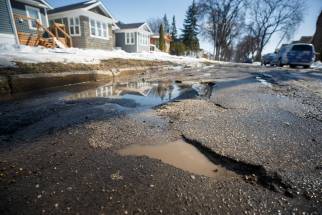Manitoba lagging on climate-change measures
Read this article for free:
or
Already have an account? Log in here »
To continue reading, please subscribe:
Monthly Digital Subscription
$0 for the first 4 weeks*
- Enjoy unlimited reading on winnipegfreepress.com
- Read the E-Edition, our digital replica newspaper
- Access News Break, our award-winning app
- Play interactive puzzles
*No charge for 4 weeks then price increases to the regular rate of $19.00 plus GST every four weeks. Offer available to new and qualified returning subscribers only. Cancel any time.
Monthly Digital Subscription
$4.75/week*
- Enjoy unlimited reading on winnipegfreepress.com
- Read the E-Edition, our digital replica newspaper
- Access News Break, our award-winning app
- Play interactive puzzles
*Billed as $19 plus GST every four weeks. Cancel any time.
To continue reading, please subscribe:
Add Free Press access to your Brandon Sun subscription for only an additional
$1 for the first 4 weeks*
*Your next subscription payment will increase by $1.00 and you will be charged $16.99 plus GST for four weeks. After four weeks, your payment will increase to $23.99 plus GST every four weeks.
Read unlimited articles for free today:
or
Already have an account? Log in here »
Hey there, time traveller!
This article was published 20/04/2022 (1329 days ago), so information in it may no longer be current.
Canada’s greenhouse-gas emissions fell sharply in 2020. Much of the decline was driven by pandemic-related measures. People drove their vehicles less, non-essential travel ground to halt and industry contracted. The happy, unintended consequence was that fewer tonnes of climate-altering carbon dioxide filled the atmosphere that year.
Canada emitted 672 million tonnes of GHGs in 2020, an 8.9 per cent drop from the previous year, according to the latest inventory report released last week. Emissions from transportation fell 12 per cent, including a near 50-per-cent reduction from aviation traffic. Manufacturing and the oil and gas sector saw declines in emissions, as did electricity output (much of which is coal fired).
Canada emitted 672 million tonnes of GHGs in 2020, an 8.9 per cent drop from the previous year, according to the latest inventory report released last week.
Not all the reductions were attributed to the pandemic. Ongoing efforts to reduce emissions, including the transition away from coal-fired electricity, contributed to the decline. Still, much of the reduction is temporary. Emissions are expected to be higher in 2021 as public-health measures loosened and the economy recovered.
Canada has a long way to go to meet its target of reducing emissions to 60 per cent of what they were in 2005 by 2030. GHGs would have to fall to 445 million tonnes by then to reach that goal.

Manitoba is not helping the cause. It is the only province that did not see a reduction in emissions in 2020. Part of the reason is that agriculture, one of Manitoba’s main industries, was the only economic sector in Canada whose emissions grew that year.
Also, Manitoba’s electricity is produced almost entirely through hydro power; any reduction in electricity use by industry during the first year of the pandemic had little impact on emissions.
Manitoba’s lack of progress on reducing emissions is not confined to 2020, however. It is one of only two provinces whose emissions have grown since 2005 (the other is Alberta). Manitoba’s emissions were up 5.6 per cent in 2020 compared with 2005. Every other province except Alberta has reduced its emissions since then, some by significant amounts.
Ontario cut emissions by 27 per cent, in large part because of its transition away from coal-fired electricity. Nova Scotia and New Brunswick have reduced output by 36 per cent and 37 per cent respectively. Even before the pandemic, five of 10 provinces – including Quebec and Ontario – had lower emissions in 2019 compared with 2005.
Even before the pandemic, five of 10 provinces– including Quebec and Ontario – had lower emissions in 2019 compared with 2005.
Not Manitoba, whose annual emissions have crept up slightly over the past 15 years, from 21 to just over 22 million tonnes (they peaked at 23 million tonnes in 2018). The province has frequently argued that because it has lower per-capita emissions than most provinces, it doesn’t have the same opportunities as other jurisdictions to reduce them.
Saskatchewan, for example, emits three times as much as Manitoba, owing in large part to its resource-based economy (the province is the second-largest oil producer in Canada).
That should not be an excuse for Manitoba to ignore its responsibilities to cut emissions. There are many opportunities in the agricultural and manufacturing sectors, as well as in transportation and waste management, to reduce emissions. Some are low-hanging fruit, such as electrifying Winnipeg’s transit buses and investing in transit to reduce the reliance on single-occupancy vehicles.
There are many opportunities in the agricultural and manufacturing sectors, as well as in transportation and waste management, to reduce emissions.
Improving methane capture at landfills and funding curbside composting are also among the many proposals governments could adopt relatively quickly. Other initiatives may take more time, such as investing in more geothermal energy, but they require political leadership and a genuine commitment to reduce overall emissions.
Manitoba is not pulling its weight in the fight against climate change. It’s time this province started taking that duty more seriously.









